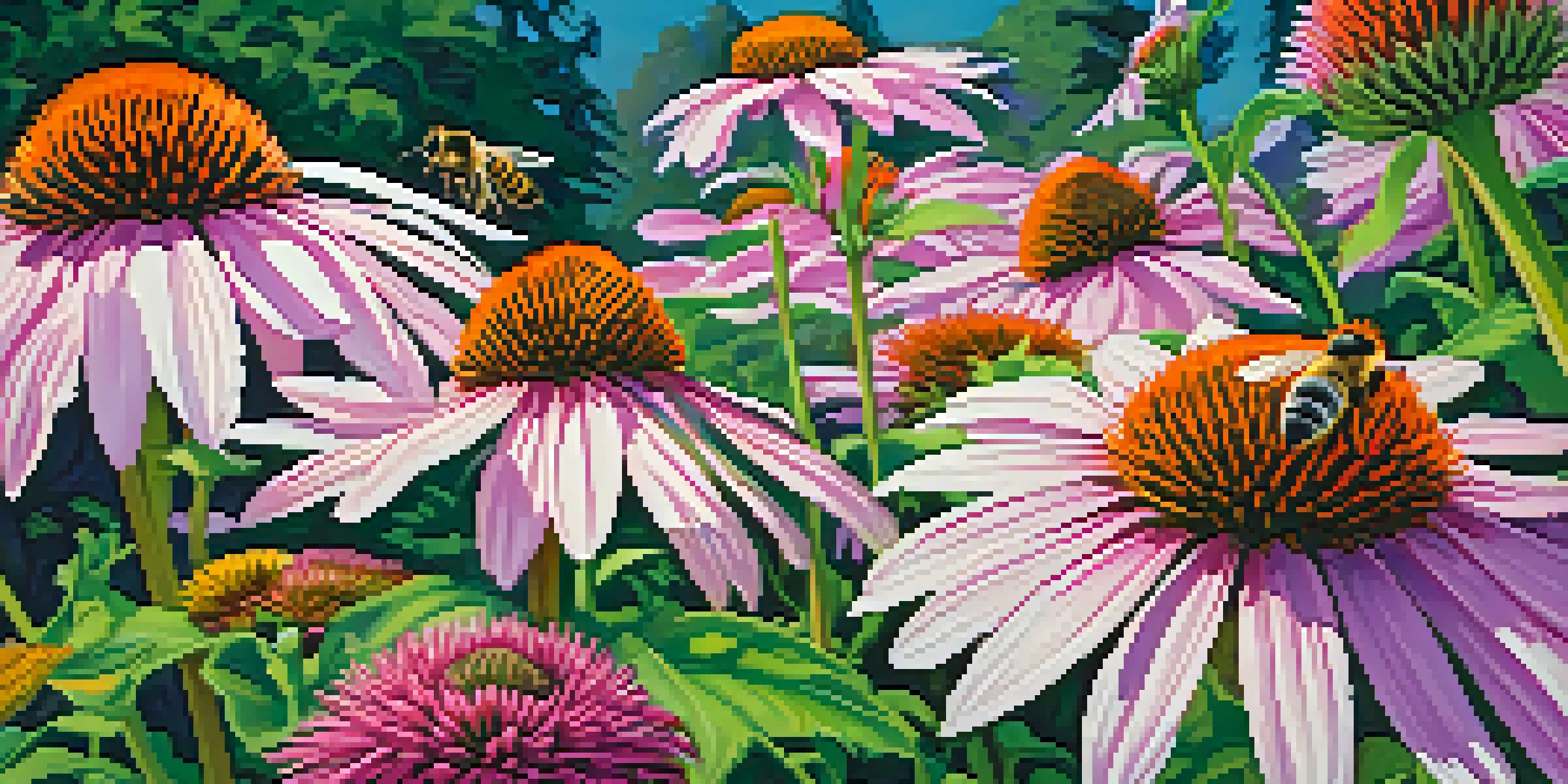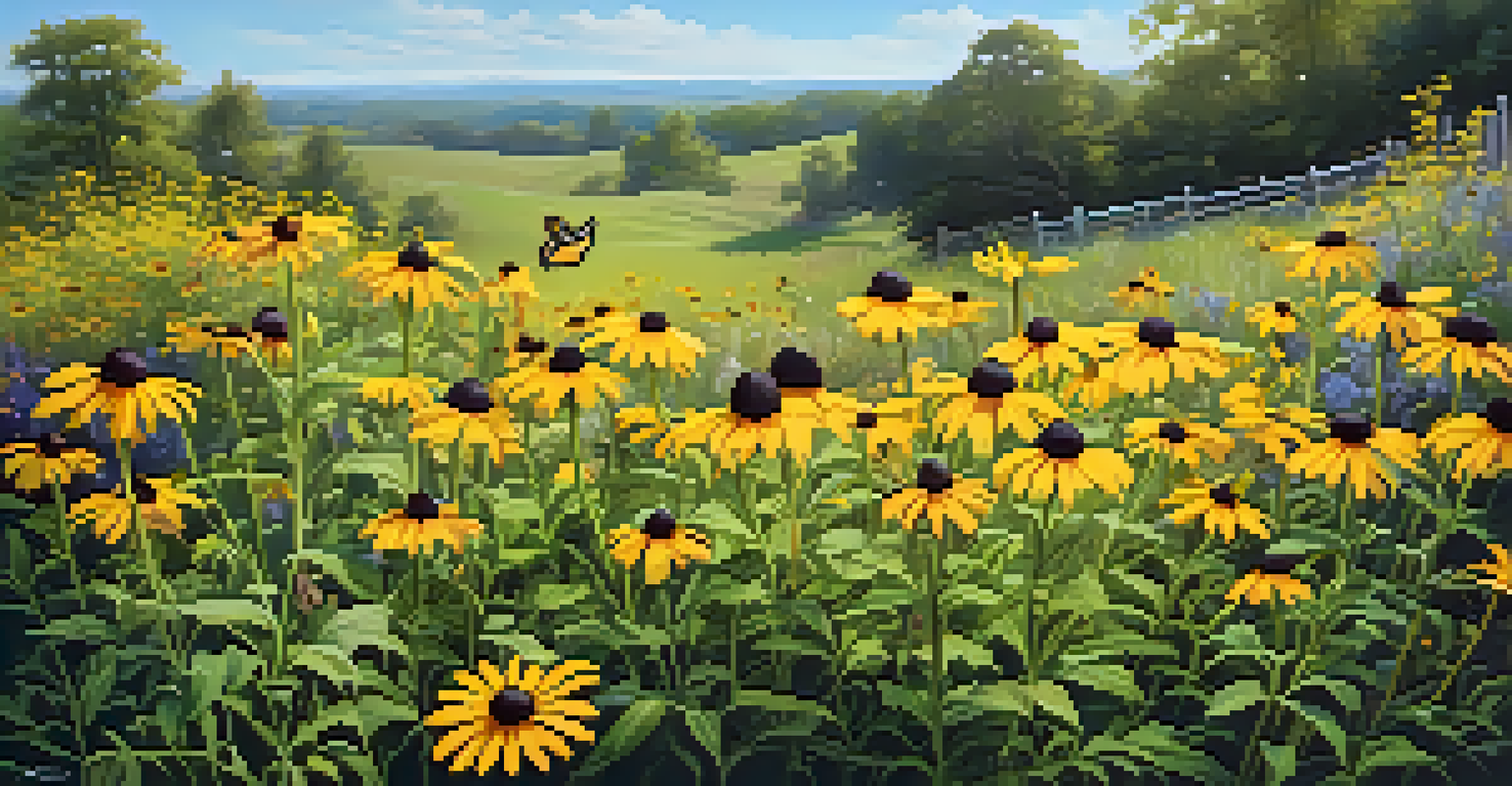Best Perennial Flowers for Attracting Pollinators to Your Yard

Why Pollinators Are Essential for Your Garden
Pollinators like bees, butterflies, and hummingbirds play a critical role in the ecosystem. They help in the fertilization of plants, which leads to the production of fruits and seeds. Without these busy little helpers, many of our favorite flowers and vegetables would struggle to reproduce.
If we could see the miracle of a single flower clearly, our whole life would change.
Creating a pollinator-friendly garden not only supports these creatures but also enhances the beauty and productivity of your outdoor space. When you attract pollinators, you’ll often notice an increase in vibrant blooms and healthier plants. It's a win-win situation for both nature and your gardening efforts.
Additionally, a garden buzzing with pollinators can provide a serene and lively atmosphere. Imagine sipping your morning coffee while watching butterflies flutter from flower to flower. It transforms gardening from a chore into a delightful experience.
Choosing the Right Perennial Flowers
When selecting perennial flowers for attracting pollinators, think about variety and bloom time. Different pollinators are attracted to different types of flowers, so having a diverse garden ensures you cater to a wide range of species. Aim for a mix of colors, shapes, and sizes for visual appeal and maximum attraction.

Also, consider the bloom time of the flowers. By planting perennials that bloom at different times throughout the growing season, you can provide a continuous food source for pollinators. This not only helps keep them in your garden but also ensures your yard is vibrant from spring through fall.
Pollinators Boost Garden Health
Attracting pollinators like bees and butterflies enhances plant fertility and the overall beauty of your garden.
Lastly, it's important to choose flowers native to your region. Native plants are often better suited for local pollinators, as they have evolved together. This means they're more likely to thrive and attract the right pollinators to your yard.
Echinacea: A Magnet for Bees and Butterflies
Echinacea, commonly known as coneflower, is a perennial favorite among pollinators. With its large, daisy-like blooms and vibrant colors, it’s no wonder that bees and butterflies are drawn to it. Echinacea flowers typically bloom in mid-summer, offering a crucial nectar source when many other flowers have faded.
The bee is more honored than other animals, not because she labors, but because she labors for others.
In addition to being beautiful, Echinacea is low-maintenance and drought-resistant, making it a great choice for busy gardeners. Once established, these hardy plants can thrive in various soil types and require minimal care. This makes them perfect for both novice and experienced gardeners alike.
Moreover, Echinacea has medicinal properties and can be used in teas and supplements, adding extra value to your garden. So, not only will you be helping pollinators, but you’ll also have a functional plant that contributes to your well-being.
Lavender: A Scented Haven for Pollinators
Lavender is another perennial that not only beautifies your garden but also attracts a variety of pollinators, especially bees. Its fragrant purple blooms are a feast for the senses, and their sweet scent can fill your garden with a delightful aroma. Plus, lavender blooms from late spring to early summer, providing an early season food source.
Aside from its appeal to pollinators, lavender is also known for its drought-tolerant qualities, making it an ideal choice for gardens in dry climates. Its ability to thrive in poor soil and require minimal watering makes it a popular choice among gardeners looking for low-maintenance options.
Choose Native Perennials Wisely
Selecting native perennial flowers with varying bloom times ensures a continuous food source for pollinators throughout the growing season.
Additionally, lavender can be harvested for culinary uses or essential oils, adding versatility to your garden. Whether you’re creating lavender-infused dishes or soothing scents, this perennial provides beauty and practicality.
Black-Eyed Susans: Bright Blooms for Pollinator Love
Black-Eyed Susans, known for their striking yellow petals and dark centers, are a staple in many gardens and a favorite among pollinators. These vibrant flowers bloom from summer to fall, providing a long-lasting source of nectar and pollen, which keeps bees and butterflies returning to your yard.
Not only are they visually appealing, but these perennials are also hardy and adaptable, flourishing in a variety of conditions. They can thrive in poor soil and are drought-resistant once established, making them an excellent choice for gardeners looking for resilience.
Furthermore, Black-Eyed Susans can easily spread through self-seeding, allowing them to create a natural garden aesthetic over time. This means less work for you while still providing a beautiful and inviting space for pollinators.
Bee Balm: A Nectar-Rich Delight
Bee Balm, or Monarda, is aptly named for its ability to attract bees, butterflies, and hummingbirds. Its vibrant, tubular flowers come in colors like red, pink, and purple, making it a stunning addition to any garden. Beyond its beauty, Bee Balm is rich in nectar, making it a favorite among pollinators.
This perennial blooms from summer to early fall, ensuring that pollinators have access to food during the late growing season. It also thrives in moist, well-drained soil and can even tolerate some shade, making it versatile for different garden layouts.
Create a Welcoming Environment
Planting in clusters, avoiding pesticides, and providing water sources can significantly improve the appeal of your garden to pollinators.
Moreover, Bee Balm has a lovely minty aroma and can be used in teas and as a culinary herb, providing even more reasons to include it in your garden. Imagine sipping on refreshing Bee Balm tea while watching the pollinators enjoy your garden!
Sedum: Hardy Succulents for Pollinator Gardens
Sedum, or stonecrop, is a hardy succulent that thrives in poor, dry soil, making it ideal for low-maintenance gardens. These plants bloom in late summer and fall, providing a late-season food source for pollinators when many other flowers have faded. Their unique, fleshy leaves and vibrant flower clusters make them an attractive addition to any garden.
Sedum varieties come in various colors, shapes, and sizes, allowing you to create visual interest in your landscape. They’re particularly appealing to butterflies, which are drawn to their flat flower clusters that provide easy landing spots for feeding.

Additionally, Sedum is drought-resistant and can thrive in challenging conditions, making it a smart choice for gardeners who want to attract pollinators without extensive upkeep. With Sedum in your garden, you’ll create a haven for pollinators while enjoying a stunning display of resilient blooms.
Tips for Creating a Pollinator-Friendly Garden
To truly create a haven for pollinators, consider planting flowers in clusters rather than single plants. Grouping flowers together makes it easier for pollinators to find food sources and encourages them to stick around. Aim for large patches of the same flower type to enhance their visibility and attract more visitors.
It's also essential to avoid pesticides and herbicides, as these chemicals can be harmful to pollinators. Instead, opt for natural pest control methods or organic alternatives to protect both your plants and the pollinators that visit them. A healthy garden ecosystem can thrive without harmful chemicals.
Finally, providing additional resources, such as water sources and shelter, can enhance your garden's appeal. Consider adding shallow dishes of water or creating small habitats with native grasses or brush piles. This creates a welcoming environment for pollinators, ensuring they feel at home in your yard.